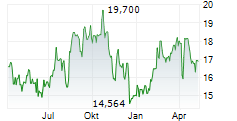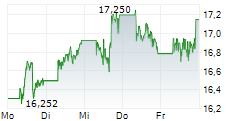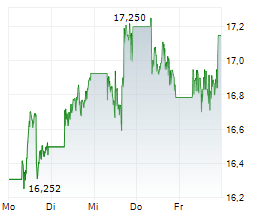Vancouver, British Columbia--(Newsfile Corp. - July 9, 2025) - Japan Gold Corp. (TSXV: JG) (OTCQB: JGLDF) ("Japan Gold" or the "Company") is pleased to announce that the initial framework drill program at the Barrick Alliance Hakuryu Project intersected gold mineralization across narrow intervals of the Hakuryu No. 3 Vein target. The Hakuryu No. 3 Vein is located on the northeastern edge of a 5km long anomalous gold trend contained within the Hakuryu Project[1], (Figure 1). The Hakuryu Project sits in the Konomai Mine district, which had historic production of 2.35 million ounces of gold.
Assay highlights include:
- 16.2 g/t Au over 0.6 meters (Drill hole: DDH-HAK-001), from 103.8 meters
(a reassay of this interval yielded 24.1 g/t over 0.6 meters, from 103.8 meters)
- 1.5 g/t Au over 3.3 meters (Drill hole: DDH-HAK-002), from 164.2 meters
Full results are presented in Tables 1 and 2.
Assay results indicate that two drillholes (DDH-HAK-001 & DDH-HAK-002) intersected anomalous gold mineralization. The mineralization is associated with a zone of hydrothermal brecciation which sits on the hanging wall side of a well-developed fault zone. The mineralization in both holes is associated with the same structural zone, indicating continuity of the mineral intersection over 145 metres of strike. Drillhole 3 (DDH-HAK-003) targeted the same structural zone but did not intersect anomalous gold, possibly due to a structural offset from faulting.
The results from the drilling are encouraging, confirming anomalous gold mineralization including the presence of high-grade mineralization within a zone of well-developed faulting and brecciation. Although no primary epithermal veins were encountered, this largely untested structural zone is part of a much more extensive corridor of alteration that extends for over 5km.
Chairman and CEO, John Proust, commented, "We are encouraged by the positive results from the maiden drill campaign at Hakuryu, which provided early indicators for significant gold mineralisation across the project. It was an important first step in the exploration of the historically well-endowed Konomai epithermal gold district. Advanced geophysics in conjunction with the geological results of the drill program will define and guide additional drilling of this largely untested prospective broader corridor."
Located on the Japanese island of Hokkaido, the Hakuryu drill program was designed to test beneath a prominent zone of surface silicification and quartz veining identified through geological mapping and supported by geochemical datasets, where surface sampling of this zone returned gold values between 0.1g/t Au to 3.0g/t Au. Originally planned for four drill holes totaling up to 700 meters, three holes totaling 568 meters were sufficient to effectively evaluate the immediate target (Figure 2 and 3). The program was fully funded by Barrick Mining Corporation under the strategic alliance with Japan Gold. Exploration activities are jointly overseen by the Japan Gold/Barrick Technical Committee.
Drill sites were fully rehabilitated to their original condition, with work completed in alignment with environmental best practices.
Japan Gold is dedicated to environmental, social and governance (ESG) principles as integral to the Company's operations. The Company is committed to maintaining high standards of environmental sustainability and social responsibility, ensuring the health, safety and well-being of its employees and of the communities in which the Company operates.
The Company is committed to using best practices to achieve sustainable operations, recognizing that the maintenance of environmental quality is vital to the Company's existence, progress, and continued development.
Table 1: Significant Mineralized Intercepts from DDH-HAK-001
(True thickness of mineralization is unknown at this time)
| Drill Hole ID | From (m) | To (m) | Length (m) | Au (ppm) | Ag (ppm) |
| DDH-HAK-001 | 101.20 | 101.80 | 0.60 | 0.35 | 4.98 |
| DDH-HAK-001 | 101.80 | 102.30 | 0.50 | 0.37 | 25.70 |
| DDH-HAK-001 | 102.30 | 102.80 | 0.50 | 0.15 | 57.20 |
| DDH-HAK-001 | 102.80 | 103.30 | 0.50 | 0.32 | 8.72 |
| DDH-HAK-001 | 103.30 | 103.80 | 0.50 | 0.23 | 9.66 |
| DDH-HAK-001 | 103.80 | 104.40 | 0.60 | 16.15 | 343 |
| Reassay | 103.80 | 104.40 | 0.60 | 24.10 | 401 |
| DDH-HAK-001 | 104.40 | 105.05 | 0.65 | 0.29 | 6.12 |
| DDH-HAK-001 | 105.05 | 106.00 | 0.95 | 0.30 | 6.22 |
| DDH-HAK-001 | 106.00 | 107.00 | 1.00 | 0.25 | 5.35 |
| DDH-HAK-001 | 107.00 | 108.00 | 1.00 | 0.12 | 6.65 |
| DDH-HAK-001 | 108.00 | 109.00 | 1.00 | 0.26 | 4.64 |
| DDH-HAK-001 | 109.00 | 110.00 | 1.00 | 0.78 | 4.32 |
Table 2: Significant Mineralized Intercepts from DDH-HAK-002
(True thickness of mineralization is unknown at this time)
| Drill Hole ID | From (m) | To (m) | Length (m) | Au (ppm) | Ag (ppm) |
| DDH-HAK-002 | 163.70 | 164.20 | 0.50 | 0.54 | 3.77 |
| DDH-HAK-002 | 164.20 | 164.70 | 0.50 | 1.47 | 3.05 |
| DDH-HAK-002 | 164.70 | 165.30 | 0.60 | 1.66 | 3.70 |
| DDH-HAK-002 | 165.30 | 165.90 | 0.60 | 1.44 | 2.91 |
| DDH-HAK-002 | 165.90 | 166.50 | 0.60 | 1.23 | 4.24 |
| DDH-HAK-002 | 166.50 | 167.00 | 0.50 | 1.79 | 3.98 |
| DDH-HAK-002 | 167.00 | 167.50 | 0.50 | 1.55 | 3.04 |
| DDH-HAK-002 | 167.50 | 168.00 | 0.50 | 0.60 | 5.15 |
| DDH-HAK-002 | 168.00 | 168.50 | 0.50 | 1.27 | 7.16 |

Figure 1: Hakuryu Project Simplified Geology Map with Drill Program and Local Anomalies
To view an enhanced version of this graphic, please visit:
https://images.newsfilecorp.com/files/5665/258274_4efb53bf041f8975_001full.jpg

Figure 2: Hakuryu Drill Program Simplified Geology and Drill Hole Results (Plan View)
To view an enhanced version of this graphic, please visit:
https://images.newsfilecorp.com/files/5665/258274_4efb53bf041f8975_002full.jpg

Figure 3: Cross sections (above) illustrating drill hole DDH-HAK-001 and DDH-HAK-002 and their gold intersections.
To view an enhanced version of this graphic, please visit:
https://images.newsfilecorp.com/files/5665/258274_4efb53bf041f8975_003full.jpg
Sampling Techniques and Assaying
The drilling results discussed in this news release are from drill core samples obtained by PQ, HQ and NQ-size triple-tube diamond core drilling using a PMC-700 drill rig owned and operated by the Company. The drilling program was fully supervised by Company senior geologists at the drilling site.
The drill core was collected in plastic core trays at the drill site and transported by road in Company vehicles to its core handling facility in the nearby Ikutahara Town, Engaru City, near the project area. The drill core was carefully logged, photographed and sample intervals were marked up along predicted mineralized and unmineralized intervals along the entirety of the drill holes by Japan Gold senior project geologists.
Sample lengths varied from 0.5 to 2.4 metres, depending on the positions of geological contacts and variations in alteration composition. The core was split by a diamond rock saw supervised by project geologists. The half-core sample was collected from the entire length of each designated sample interval and placed into individual-labelled, self-sealing calico bags for secure packaging and transport to the laboratory. The half-core samples weighed between 0.9 to 8.0 kilograms depending on the sample length and core size. A chain of custody was established between the Company and the receiving laboratory to ensure the integrity of the samples during transportation from the site to the lab. The samples were sent in batches to ALS Laboratories in Vancouver, Canada for sample preparation and assaying.
Samples were crushed, pulverized and assayed for gold 50-gram charge Fire Assay / AAS Finish (Au-AA24; 0.005 ppm lower detection limit) and a 48 multi-element by 4-acid digest with ICP-MS determination (ME-MS61L; Ag 0.002 ppm lower detection limit). Over-limit Au and Ag samples were re-assayed by fire-assay and gravimetric finish (GRA-22, LDL of 0.5 and 5 ppm for Au and Ag respectively).
Certified Reference Materials ("CRMs") were inserted by Japan Gold KK at every 20th sample to assess the repeatability and assaying precision of the laboratory. In addition, the laboratory applied its own internal Quality Control procedure that includes sample duplicates, blanks & geochemical standards. They report these results with the certified Assay Report. Laboratory procedures and QA/QC protocols adopted are considered appropriate. The CRMs and internal QA/QC results fall within acceptable levels of accuracy & precision and are considered to lack any bias.
Qualified Person
The technical information in this news release has been reviewed and approved by Japan Gold Senior Technical Advisor, Fraser MacCorquodale, BAppSc, MAIG, MSEG, who is a Qualified Person as defined by National Instrument 43-101.
About Japan Gold Corp.
Japan Gold Corp. is a Canadian mineral company focused on the exploration and discovery of high-grade epithermal gold deposits across the main islands of Japan. The Company holds a significant portfolio of tenements covering areas with known gold occurrences, history of mining and prospective for high-grade epithermal gold mineralization in one of the most stable and under explored countries in the world. The Japan Gold leadership and operational team of geologists, drillers and technical advisors have extensive experience exploring and operating in Japan and have a track record of discoveries world-wide. Japan Gold has an alliance with Barrick Mining Corporation to jointly explore, develop and mine certain gold mineral properties and mining projects with the potential to host Tier 1 or Tier 2 gold ore bodies in Japan. Significant shareholders include Equinox Partners Investment Management LLC and Newmont Corporation.
On behalf of the Board of Japan Gold Corp.
John Proust
Chairman & CEO
For further information, please contact:
Alexia Helgason
Vice President, Corporate Communications
Phone: +1(604) 417-1265
Email: ahelgason@japangold.com
Cautionary Note
Neither the TSX Venture Exchange nor its Regulation Services Provider (as such term is defined in the policies of the TSX Venture Exchange) accepts responsibility for the adequacy or accuracy of this release. This news release contains forward-looking statements relating to expected or anticipated future events and anticipated results related to future partnerships and the Company's 2025 gold exploration program. These statements are forward-looking in nature and, as a result, are subject to certain risks and uncertainties that include, but are not limited to, the timing and granting of prospecting rights; the Company's ability to convert prospecting rights into digging rights within the timeframe prescribed by the Mining Act; general economic, market and business conditions; competition for qualified staff; the regulatory process and actions; technical issues; new legislation; potential delays or changes in plans; working in a new political jurisdiction; results of exploration; the Company's ability to execute and implement future plans, arrange or conclude a joint venture or partnership; and the occurrence of unexpected events. Actual results achieved may differ from the information provided herein and, consequently, readers are advised not to place undue reliance on forward-looking information. The forward-looking information contained herein speaks only as of the date of this News Release. The Company disclaims any intention or obligation to update or revise forward-looking information or to explain any material difference between such and subsequent actual events, except as required by applicable laws.
[1] Sumitomo Metal Mining Co., Ltd. (Editorial Committee), Oct. 2023. The Konomai Mine History 50th Anniversary - The History of Sumitomo Konomai Gold Mine, p. 58
Historic mines/workings locations - A Tectonic Model for Epithermal Au Mineralization in NE Hokkaido, Japan. Yasushi Watanabe. Resource Geology Special Issue, No.18, p. 261-236 1995.
Geological Survey of Japan

To view the source version of this press release, please visit https://www.newsfilecorp.com/release/258274
SOURCE: Japan Gold Corp.



